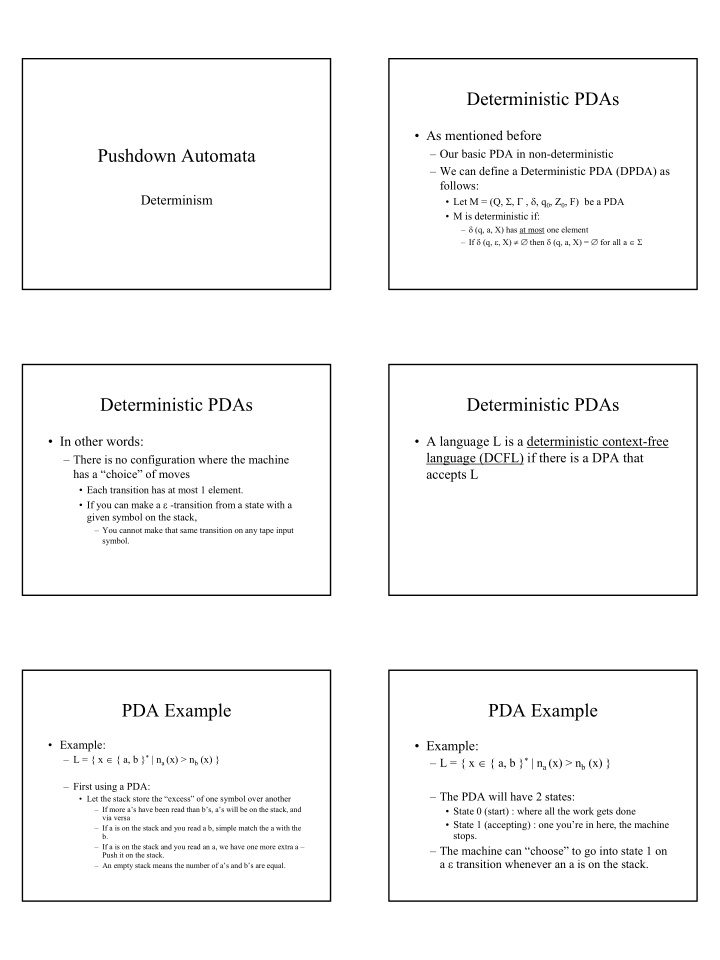



Deterministic PDAs • As mentioned before Pushdown Automata – Our basic PDA in non-deterministic – We can define a Deterministic PDA (DPDA) as follows: Determinism • Let M = (Q, Σ , Γ , δ , q 0 , Z 0 , F) be a PDA • M is deterministic if: – δ (q, a, X) has at most one element – If δ (q, ε , X) ≠ ∅ then δ (q, a, X) = ∅ for all a ∈ Σ Deterministic PDAs Deterministic PDAs • In other words: • A language L is a deterministic context-free language (DCFL) if there is a DPA that – There is no configuration where the machine accepts L has a “choice” of moves • Each transition has at most 1 element. • If you can make a ε -transition from a state with a given symbol on the stack, – You cannot make that same transition on any tape input symbol. PDA Example PDA Example • Example: • Example: – L = { x ∈ { a, b } * | n a (x) > n b (x) } – L = { x ∈ { a, b } * | n a (x) > n b (x) } – First using a PDA: – The PDA will have 2 states: • Let the stack store the “excess” of one symbol over another – If more a’s have been read than b’s, a’s will be on the stack, and • State 0 (start) : where all the work gets done via versa • State 1 (accepting) : one you’re in here, the machine – If a is on the stack and you read a b, simple match the a with the stops. b. – If a is on the stack and you read an a, we have one more extra a – – The machine can “choose” to go into state 1 on Push it on the stack. a ε transition whenever an a is on the stack. – An empty stack means the number of a’s and b’s are equal.
PDA Example PDA Example • Example: • Let’s try on JFLAP – L = { x ∈ { a, b } * | n a (x) > n b (x) } b, Z 0 / b Z 0 a, Z 0 / a Z 0 ε , a / a q 0 q 1 b, b / bb a, b / ε a, a / aa b, a / ε Non-determinism PDA Example PDA Example Example: • Example: – L = { x ∈ { a, b } * | n a (x) > n b (x) } – L = { x ∈ { a, b } * | n a (x) > n b (x) } – Removing the non-determinism : – The PDA will have 2 states: • Let the stack store 1 minus the “excess” of one • State 0 (start) : when n a (x) ≤ n b (x) symbol over another – Equality or surplus of b’s • The state will determine whether you have excess • State 1 (accepting) : when n a (x) >n b (x) a’s or excess b’s – Surplus of a’s PDA Example PDA Example • Example: • Let’s try on JFLAP – L = { x ∈ { a, b } * | n a (x) > n b (x) } a, a / aa b, Z 0 / b Z 0 a, Z 0 /a Z 0 b, b / bb b, a / ε a, Z 0 / Z 0 a, b / ε q 0 q 1 b, Z 0 / Z 0
Now you might be wondering… It can be shown… We know that all DCFLs are CFLs • That the language pal: – pal = { x ∈ { a, b } * | x = x r } CFL • Cannot be accepted by any DPDA. DCFL Is there anything in here? It can also be shown Now our picture looks like • That all regular languages can be accepted Context Free Languages by a DPDA. Deterministic Context Free Languages – Since an DFA is essentially a DPDA that doesn’t make use of the stack. Regular Languages Finite Languages Why DPDAs are important Determinism vs. Non-Determinism • Comparing FAs and PDAs • A compiler may wish to implement a PDA – DPDAs allow for ε -transitions in software to parse a program given by a – DPDAs allow for no moves given grammar • DPDAs and ambiguity – FAs and NFAs are equivalent – If L can be accepted by a DPDA, then L can be – PDAs and DPDAs are not equivalent expressed by an unambiguous CFG – Not visa versa – Questions – Theorems 6.20 / 6.21 in text
Recommend
More recommend